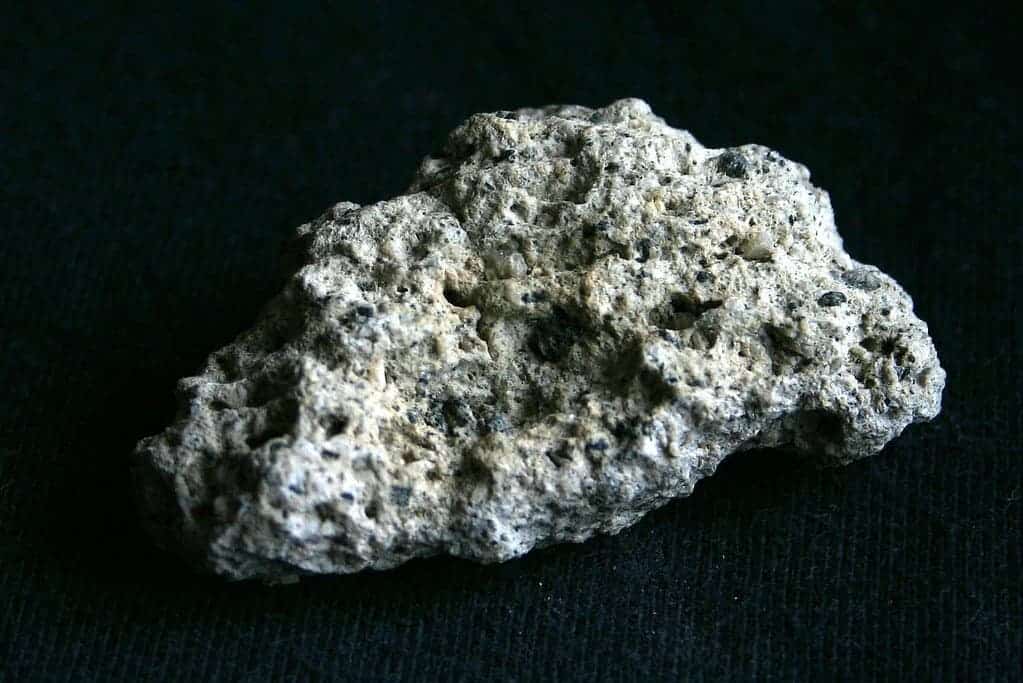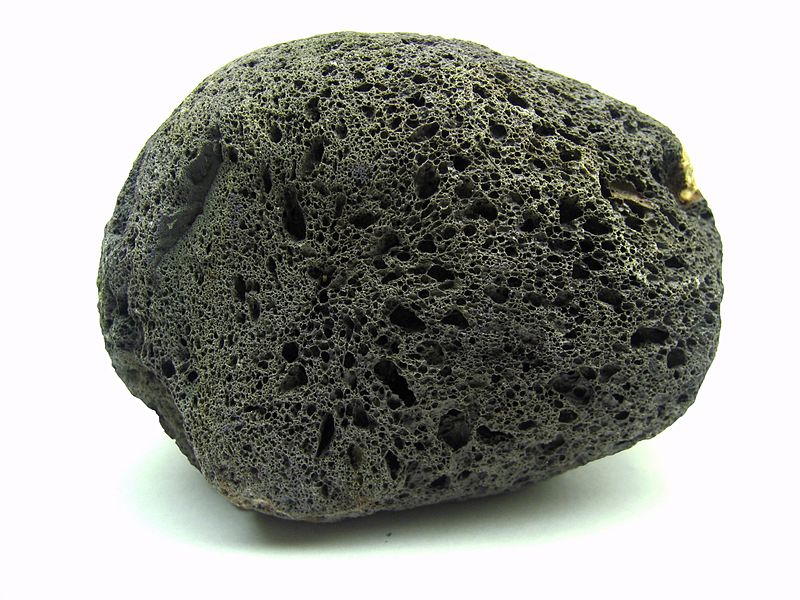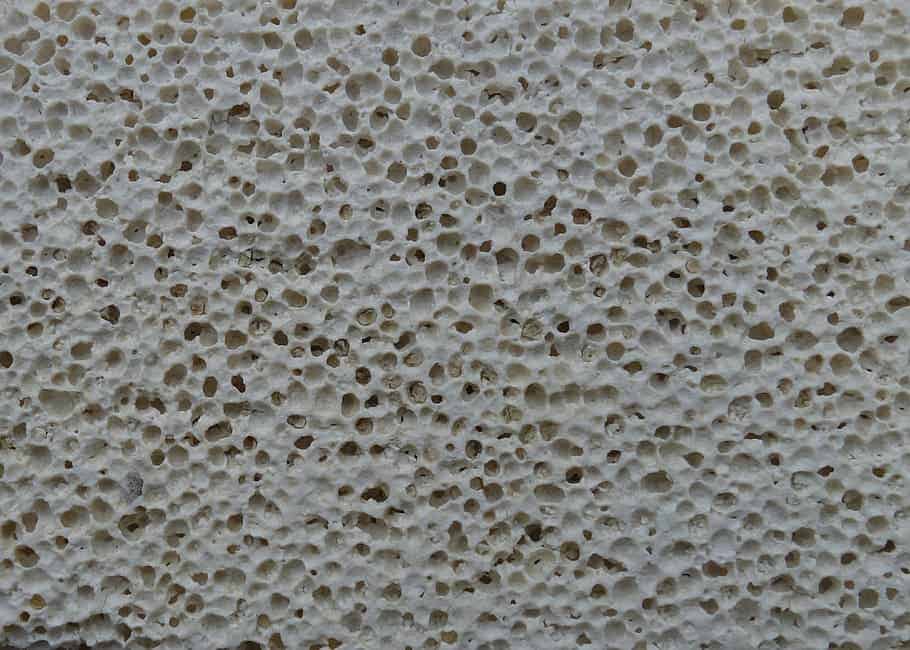Often found in cosmetics shops and beauty tip articles, this funnily-named rock has a very violent origin.

Pumice is a lightly colored rock with a very foamy structure. It’s so porous, in fact, that most specimens can float on water (until they eventually become waterlogged and sink). The secret to its structure lies in the birth of pumice: violent volcanic eruptions.
Out with a bang!
Some volcanoes pop off quite violently. It happens to those whose magma is very thick, viscous, and has a high content of volatiles (mostly water and some carbon dioxide). During such an explosive eruption, highly-pressurized magma inside the volcano is ejected to the surface or underwater. Here, it rapidly cools and depressurizes. The whole process is a lot like throwing a mind in a bottle of coke, and at this stage, the lava looks a lot like the foam. The volatiles inside it bubble up as the lava cools and hardens, creating pumice.
So you can think of pumice as being frozen foam du lava. Its very name shares a root with the Latin word ‘spumam’ (‘foam’).
Pumice stone is usually created by underwater volcanoes. Particularly large eruptions can spawn whole islands or rafts of the stuff, but even humbler events can generate enough material to threaten cargo ships. Under certain conditions it can also form in subaerial (i.e. not-underwater) settings. If the source magma has a high level of volatile materials, a finer-grained variety known as pumicite can form instead. Less viscous magmas, in which gases can form bubbles more readily, create denser (and non-floaty) scoria. However, if there’s no eruption, there won’t be any pumice — it’s an extrusive ‘igneous’ mineraloid, so all deposits are centered around areas of current or past volcanic activity.

Image credits Jon Zander / Wikimedia.
However, if there’s no eruption, there won’t be any pumice — it’s an extrusive ‘igneous’ mineraloid — so all deposits are centered around areas of current or past volcanic activity.
Pumice stone isn’t exactly a rock in the strictest geological sense of the word because it has no internal crystalline structure. It cools too quickly for its atoms to arrange themselves the way they’d like to, so it has an overall amorphous (disorganized), glass-like structure. It can contain crystals, but these will be embedded in the amorphous matrix of the pumice — its exact make-up depends on the nature of its source magma. Instead, pumice is considered to be a mineraloid or a type of volcanic glass.
So let’s see what it’s good for.
Cosmetics

Image Patrick Reijnders / Flickr.
It’s probably best-known for its cosmetic uses. Glass is quite hard, and volcanic glass isn’t any different, so it’s a very good abrasive.
The simplest way to employ a piece of raw pumice stone is to soften an area of calloused skin with warm water and then gently rub the stone on it to scrape it off. In our gentler, modern times, powdered pumice stone is often added to soaps or body gels to improve their cleaning power, or in creams and beauty products meant to exfoliate the skin. It’s a completely natural, generally chemically-inert, and has a neutral PH; it’s also more eco-friendly than synthetic alternatives such as plastic microbeads, making it quite popular in the public eye.
Cleaning, abrasives
Household cleaning products like scouring pastes and powders can also include pumice, which helps them better scrape off hardened, encrusted nastiness.
Industrial settings rely on pumice as mild abrasives in tasks where a particular surface needs scrubbing with a gentle touch. Pumice and its powders see use in glass polishing, the cleaning and texturing of electronic circuit boards, the cleaning of lithographic plates, the removal of surface oxide layers in metal surfaces meant for electroplating, the buffing of leather and fine woods, and as a tumbling agent for metal and plastic parts. The crumbly nature of pumice together with its high hardness means it can be processed without it losing effectiveness on tough surfaces.
In dentistry
Because it’s mildly abrasive and non-reactive, pumice powder is mixed into many whitening toothpastes and teeth polish products. This tradition runs back in excess of 4,000 years, with ancient Egyptians first employing the mineraloid in this role. Today, the powder sees use in dentistry as a cleaning and polishing agent, and for its antibacterial properties. The powder is also used to prepare teeth for resin fillings.
For water filtration and retention

Image via Pxfuel.
Pumice can act as a pretty good filtration method due to its porous internal structure. Some advantages of pumice as a filtration medium are its effectiveness in removing particles, low filtration bed expansion, and relatively low cost of maintenance or replacement of the pumice. Being non-toxic and inert means it doesn’t dissolve or change the taste of whatever liquid it’s filtering.
The mineraloid is also quite effective at scrubbing biological material (such as hydrogen sulfide, mercaptans, and other volatile organics) from wastewater. The quality of the pumice, its production, processing, and transport has a big impact on the quality of the final filters, however. If you do plan to build a pumice filter, make sure to wash the material thoroughly beforehand.
Mixing in pumice with soils can help enhance its natural water-filtration abilities, and this approach has been used in low-impact ecological projects to prevent contamination and runoff from entering streams, lakes, or the water table.
Pumice stone can also be used as a substrate or mixed in with soils for plants as it can store moisture when the plants are overwatered and gradually release it as the soil dries up. Furthermore, its porous nature means it improves water and gas circulation through the soil, giving plants easier access to the nutrients they need — this is especially important in compact soils with lots of clay or for hydroponics. Golf courses often use pumice stone to maintain grass cover and the shape of the landscape despite the heavy traffic they see.
As a chemical and mechanical absorbent
The structure of pumice makes it very good at absorbing liquids, kind of like a mineral sponge. With adequate processing, this ability can increase quite dramatically. As such, pumice sees use in a wide range of tasks where liquids need to be contained, ranging from kitty litter to dry petroleum/chemical absorbents.
One of the more niche uses of the mineraloid is in bomb mitigation. Explosions cause damage through high-velocity shock waves that blast objects or structures with immense mechanical energy. In order to protect yourself from the explosion, you need to either stand far away (the energy dissipates with distance) or to use it up (bodies absorb the energy as they are deformed).
As we’ve seen earlier, pumice is quite hard, and it has a very complex internal structure. Breaking and squashing this structure into a compact block takes a lot of energy, as the pores inside the stone get compacted in sequence (i.e. the blast needs to deform the pumice throughout its volume). All in all, this makes pumice a very effective blast mitigation compound, and it sees use in bomb encasements to prevent damage from accidental detonations.
Paints, rubber, concrete

Image in the public domain.
When mixed into paints and coatings as a filler, pumice helps them better retain color over time, makes them more resistant, and increases resistance to burnishing, staining, and scrubbing.
It can also be mixed into rubber. Pumice-reinforced tires have better performance of ice and snow, as the material helps increase friction; it’s useful in rubber abrasive wheels for the same reason. You’re overwhelmingly likely to have handled pumice rubber before — pencil erasers are made of this material as the mineral helps remove graphite from paper.
Finally, pumice aggregate concrete, which has been in use since the ancient Romans, offers much the same mechanical properties of regular concrete but with up to one-third reduction in weight (depending on the composition). Pumice concretes, however, have improved thermal, acoustic, and elastic properties compared to regular concrete.
I really like pumice because, on first sight, it doesn’t look like much. It’s brittle and untastefully light for a stone. But in a way, it’s a very good allegory for scientific knowledge: if you take the time to learn about it, even something that seems bland and uninteresting can whiten your teeth, clear up chemical spills, and stunt explosions all at the same time.


